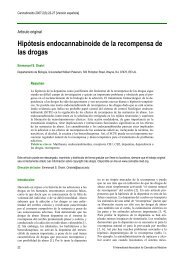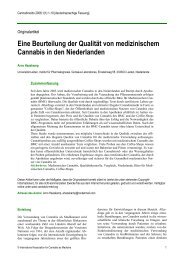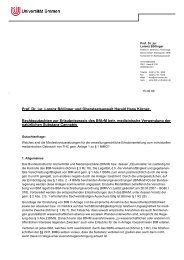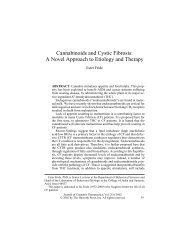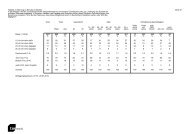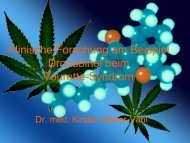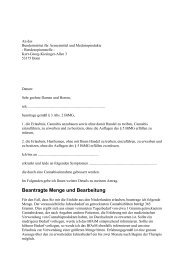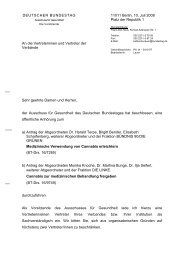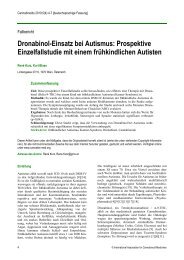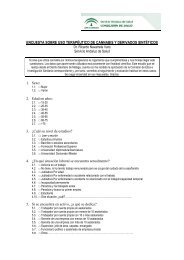PDF des gesamten Artikels - International Association for ...
PDF des gesamten Artikels - International Association for ...
PDF des gesamten Artikels - International Association for ...
- Keine Tags gefunden...
Erfolgreiche ePaper selbst erstellen
Machen Sie aus Ihren PDF Publikationen ein blätterbares Flipbook mit unserer einzigartigen Google optimierten e-Paper Software.
Originalartikel2. Salamone JD, Correa M, Mingote SM, WeberSM. Beyond the reward hypothesis: alternativefunctions of nucleus accumbens dopamine. Curr.Opin. Pharmacology. 2005; 5: 34-41.3. Horvitz JC. Mesolimbocortical and nigrostriataldopamine responses to salient non-reward events.Neuroscience. 2000; 651-656.4. Roll ET. Emotion explained. 1st ed. Ox<strong>for</strong>d. NY.2005.5. Cannon MC, Palmiter RD. Reward without dopamine.J Neuroscience. 2003; 23: 10827-10831.6. Hnasko TS, Sotak BN, Palmiter RD. Morphinereward in dopamine-deficient mice. Nature. 2005;438: 854-857.7. Koob GF, Le Moal M. Drug abuse: hedonic homeostaticdysregulation. Science. 1997; 278: 52-58.8. Yamamoto T, Anggadiredja K, Hiranita T. Newperspectives in the studies on endocannabinoidand cannabis: A role <strong>for</strong> the endocannabinoidarachidonicacid pathway in drug reward andlong-lasting relapse to drug taking. J PharmacolSci. 2004; 96: 382-388.9. De Vries TJ, Schoffelmeer ANM. CannabinoidCB1 receptors control conditioned drug seeking.Trends Pharmacol Sci. 2005; 26: 420-426.10. Parolaro D, Vigano D, Rubino T. Endocannabinoidand drug dependence. Curr Drug Target –CNS Neurol Disorders. 2005; 4: 643-655.11. Maldonado F, Valverde O, Berrendero F. Involvementof the endocannabinoid system in drugaddiction. Trends Neurosci. 2006; 29: 225-232.12. Fattore L, Spano MS, Deiana S, Melis V, CossuG, Fadda P, Fratta W. An endocannabinoid mechanismin relapse to drug seeking: A review ofanimal studies and clinical perspectives. BrainRes Rev. 2007; 53: 1-16.13. Onaivi ES, Sugiura T, Di Marzo V, editors. Thebrain and body’s marijuana and beyond. 1st ed.Boca Raton. CRC Taylor and Francis; 2006.14. Di Marzo. Cannabinoids. Handbook of experimentalpharmacology. Ed. Pertwee. Springer-Verlag, Heidelberg. 2005.15. Giuffrida A, Piomelli D. The endocannabinoidsystem: a physiological perspective on its role inpsychomotor control. Chem. Phys. Lipids. 2000;108: 151-158.16. Van Sickle MD, Duncan M, Kingsley PJ, MouihateA, Urbani P, Mackie K, Stella N, MakriyannisA, Piomelli D, Davidson JS, Di Marzo V,Pittman QJ, Patel KD, Sharkey KA. Identificationand functional characterization of brainstem cannabinoidCB2 receptors. Science. 2005; 310: 329-332.17. Gong JP, Onaivi ES, Ishiguro H, Liu QR, TagliaferroPA, Brusco A, Uhl GR. Cannabinoid CB2receptors: immunohistochemical localization inrat brain. Brain Res. 2006; 1071: 10-23.18. Onaivi ES. Neuropsychobiological evidence <strong>for</strong>the functional presence and expression of cannabinoidCB2 receptors in the brain. Neuropsychobiology.2006; 54: 231-246.19. Ishiguro H, Iwasaki L, Teasenfitz L, Higuchi S,Horiuchi Y, Saito T, Arinami T, Onaivi ES. Involvementof cannabinoid CB2 receptor in alcoholpreference in mice and alcoholism in humans.The Pharmacogenomics J. 2006; Epub ahead ofprint.20. Chaperon F, Soubrie P, Puech AJ, Theibot MH.Involvement of central cannabinoid (CB1) in theestablishment of place conditioning in rats. Psychopharmacology.1999; 135: 324-332.21. Poncelet M, Barnouin MC, Breliere JC, Le FurG, Soubrie P. Blockade of CB1 receptors bySR141716 selectively antagonizes drug-inducedreinstatement of exploratory behavior in gerbils.Psychopharmacology. 2003; 144: 144-150.22. Reid MJ, Bornheim LM. Cannabinoid-inducedalterations in brain disposition of drugs of abuse.Biochem. Pharmacol. 2001; 61: 1357-1367.30 Cannabinoids Vol 2, No 3 30. September 2007




